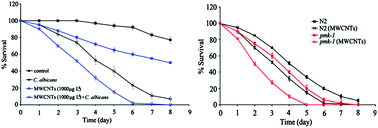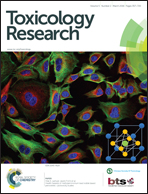Multi-walled carbon nanotubes enhanced fungal colonization and suppressed innate immune response to fungal infection in nematodes†
Abstract
The underlying molecular mechanisms for multi-walled carbon nanotube (MWCNT)-induced in vivo toxicity on innate immunity are still largely unclear. Considering the potential of Caenorhabditis elegans for the study of innate immune response of animals, we employed this in vivo assay system to investigate the effects of MWCNTs on innate immune response of animals and the underlying mechanisms. Pre-exposure to MWCNTs at concentrations more than 100 μg L−1 enhanced the adverse effect of fungal infection in reducing lifespan. With regard to the underlying cellular mechanisms, we found that MWCNT pre-exposure enhanced colony formation of Candida albicans in the body of nematodes, and suppressed innate immune response of nematodes by decreasing expression levels of some antimicrobial genes. With regard to the underlying molecular mechanisms, we found that MWCNTs decreased expression levels of pmk-1, sek-1, and nsy-1 genes encoding the p38 mitogen activated protein kinase (MAPK) signaling pathway, and inhibited translational expression of PMK-1::GFP in the intestine and phosphorylation of PMK-1. Epistasis assays showed that MWCNTs required the involvement of the p38 MAPK signaling pathway mediated by a NSY-1-SEK-1-PMK-1 cascade to enhance the toxicity of fungal infection, increase fungal colony formation, and suppress innate immune response. Thus, our results suggest that MWCNTs may possess immunoinhibitory effects by affecting the functions of the p38 MAPK signaling pathway. Our study also provides meaningful insights into the role of innate immune system of hosts against the toxicity of environmental toxicants.


 Please wait while we load your content...
Please wait while we load your content...